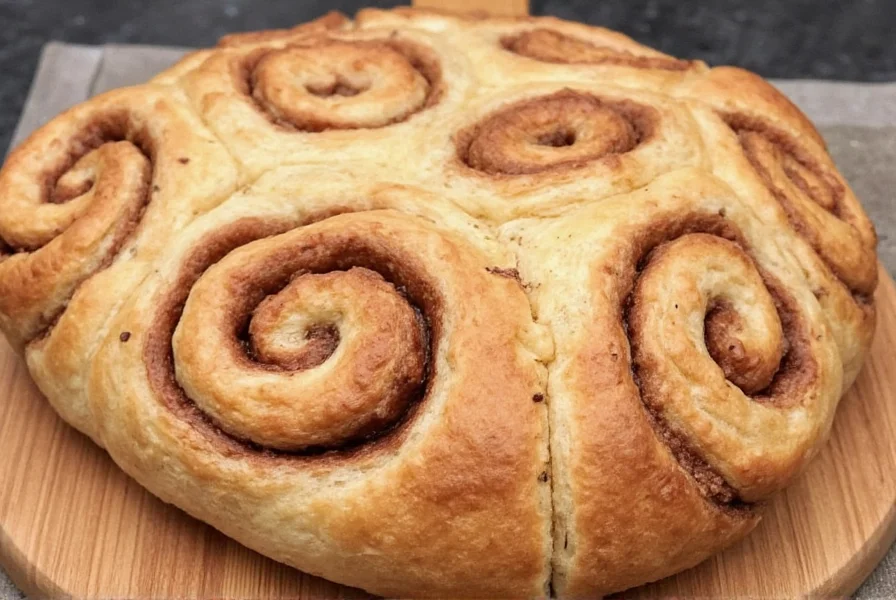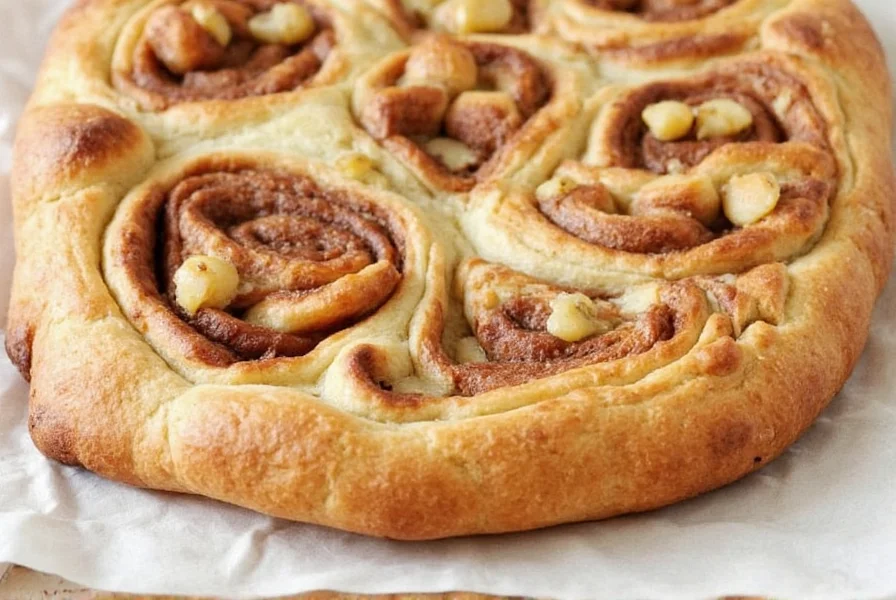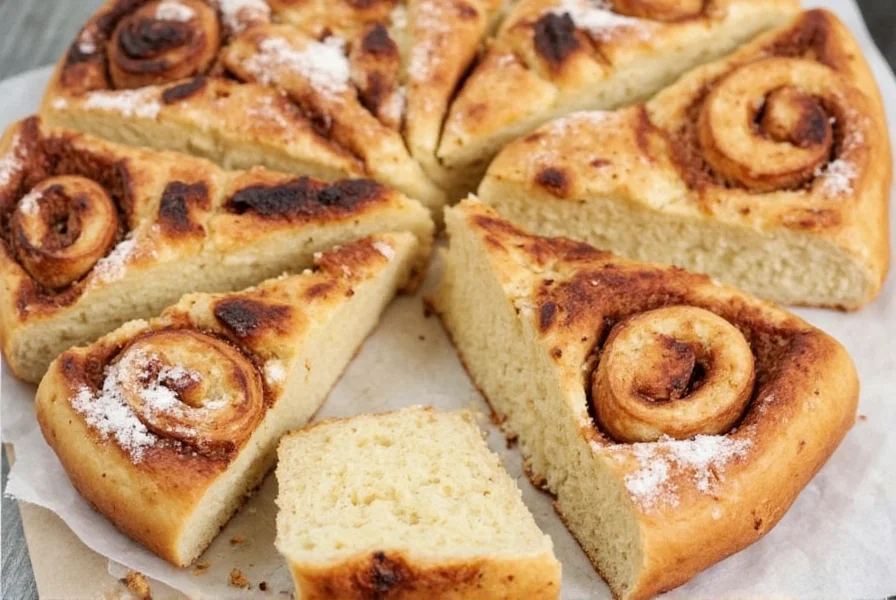The Art of Combining Three Beloved Baked Goods
When you first encounter the concept of cinnamon roll sourdough focaccia, it might seem like an unlikely marriage of baking traditions. Yet this innovative creation has gained traction among home bakers seeking to elevate their sourdough game with dessert-inspired flavors. Unlike traditional focaccia which emphasizes olive oil and herbs, or cinnamon rolls that rely on enriched dough, this hybrid approach transforms the naturally tangy sourdough starter into a vehicle for sweet indulgence while maintaining structural integrity.
The magic happens through careful balancing of hydration levels, fermentation time, and ingredient ratios. Sourdough's natural acidity cuts through the sweetness of the cinnamon filling, while the focaccia's high hydration (typically 75-80%) creates an open crumb structure that accommodates the swirl without collapsing during baking. Professional bakers have discovered that the extended fermentation of sourdough actually enhances the complexity of the cinnamon flavor profile, creating notes you'd never achieve with commercial yeast alone.
Why This Hybrid Approach Works Scientifically
Understanding the chemistry behind cinnamon roll sourdough focaccia explains its growing popularity. Sourdough's lactic acid bacteria interact with the cinnamon's essential oils during the slow fermentation process, creating new flavor compounds that standard cinnamon rolls lack. The extended bulk fermentation (typically 4-6 hours at room temperature) allows for optimal flavor development while maintaining the dough's strength.
Unlike enriched doughs used in traditional cinnamon rolls, sourdough's lean composition (just flour, water, salt, and starter) provides the necessary structure to support the cinnamon swirl without becoming dense. The focaccia technique of dimpling the dough before baking creates pockets that help contain the filling during oven spring, preventing leakage that often plagues standard cinnamon roll preparations.
| Ingredient | Amount | Function |
|---|---|---|
| Bread flour | 500g | Provides gluten structure for optimal rise |
| Sourdough starter (100% hydration) | 100g | Natural leavening and flavor development |
| Water | 375g | Achieves proper 75% hydration for open crumb |
| Salt | 10g | Strengthens gluten and balances sweetness |
| Cinnamon sugar filling | 120g | 100g brown sugar + 20g cinnamon |
| Butter (room temperature) | 60g | Creates barrier between dough and filling |
Step-by-Step Preparation Guide
Creating successful cinnamon roll sourdough focaccia requires attention to timing and technique. Begin with an active sourdough starter at its peak ripeness—this ensures maximum leavening power to support the added weight of the filling. The dough mixing process follows standard sourdough procedures with one critical modification: reserve 20g of water to dissolve your cinnamon sugar mixture, preventing clumping and ensuring even distribution.
After completing your stretch and folds during bulk fermentation, gently roll out the dough to a 12x16 inch rectangle. Spread softened butter evenly across the surface, then sprinkle your cinnamon sugar mixture. Starting from the long edge, roll the dough tightly into a log, then coil it into a spiral within your oiled pan. This coiling technique—borrowed from cinnamon roll methodology—creates the signature swirl pattern when sliced after baking.
Common Challenges and Professional Solutions
Many bakers encounter issues with filling leakage or structural collapse when attempting cinnamon roll sourdough focaccia. The primary culprit is usually inadequate dough strength before adding the filling. To prevent this, ensure your bulk fermentation completes with proper windowpane development—your dough should stretch thin without tearing.
Another frequent problem is uneven cinnamon distribution. Professional bakers recommend mixing your cinnamon sugar with a small amount of cornstarch (about 1 tablespoon per cup of sugar) which absorbs moisture and prevents clumping. For optimal results, chill the rolled dough for 30 minutes before baking—this solidifies the butter layer, creating a barrier that contains the filling during oven spring.
Variations for Different Dietary Preferences
This versatile recipe adapts beautifully to various dietary needs without compromising flavor. For a vegan version, substitute the butter with coconut oil and use plant-based cream cheese in the glaze. Gluten-sensitive bakers have found success using a 50/50 blend of bread flour and gluten-free all-purpose flour with added xanthan gum.
Seasonal variations include adding orange zest to the dough for a citrus-cinnamon profile, or incorporating toasted pecans into the filling for added texture. Some artisan bakers experiment with cardamom or nutmeg in the cinnamon mixture, creating complex flavor layers that complement the sourdough's natural tang.

Serving and Storage Recommendations
Cinnamon roll sourdough focaccia achieves peak flavor when served slightly warm, allowing the cream cheese glaze to melt into the dimpled surface. For optimal texture, let the bread rest for 15 minutes after baking before slicing—this allows the crumb structure to set properly. Unlike traditional cinnamon rolls that stale quickly, the sourdough component extends shelf life significantly.
Store leftovers in an airtight container at room temperature for up to 3 days. To refresh, wrap individual slices in damp parchment paper and warm in a 300°F oven for 8-10 minutes. Freezing works exceptionally well with this hybrid bread—slice before freezing, then toast directly from frozen for a quick treat that maintains its structural integrity better than standard cinnamon rolls.

Troubleshooting Your Cinnamon Roll Sourdough Focaccia
If your creation spreads too much during baking, your dough likely needed more strength development during bulk fermentation. Next time, perform additional stretch and folds or extend your fermentation time by 30-60 minutes. For fillings that sink to the bottom, ensure your dough has properly relaxed after rolling—chilling the shaped loaf helps maintain structure.
When the sourdough tang overwhelms the cinnamon flavor, reduce your fermentation time by 1-2 hours or decrease your starter percentage slightly. Remember that sourdough's acidity mellows during baking, so don't overcompensate with excessive cinnamon which can become bitter. Professional bakers often find that a 20% reduction in cinnamon from standard roll recipes yields perfect balance in this hybrid application.
Frequently Asked Questions
Can I use active dry yeast instead of sourdough starter for cinnamon roll focaccia?
Yes, but the flavor profile will differ significantly. Substitute 7g active dry yeast for the sourdough starter and reduce total water by 25g. Expect a milder flavor and less complex crumb structure. The baking time remains similar, but the characteristic sourdough tang that balances the sweetness will be absent.
How do I prevent my cinnamon filling from leaking during baking?
Three key techniques prevent leakage: 1) Ensure proper dough strength through adequate bulk fermentation 2) Chill the shaped loaf for 30 minutes before baking to solidify the butter layer 3) Mix your cinnamon sugar with 1 tablespoon cornstarch per cup of sugar to absorb moisture. Professional bakers also recommend leaving a ½ inch border when spreading filling to create a natural seal.
What's the ideal sourdough hydration level for cinnamon roll focaccia?
75-80% hydration provides the optimal balance. Higher hydration creates the open crumb structure characteristic of focaccia while maintaining enough strength to support the cinnamon swirl. Below 75%, the dough becomes too dense; above 80%, it struggles to contain the filling. Adjust water content based on your flour's absorption rate and ambient humidity.
Can I prepare cinnamon roll sourdough focaccia dough in advance?
Absolutely. Complete the bulk fermentation, shape your loaf, and refrigerate overnight. The cold fermentation enhances flavor complexity while making the dough easier to handle. Remove from refrigerator 2 hours before baking to allow proper oven spring. Many professional bakers prefer this method as the extended cold fermentation develops deeper cinnamon notes.
Why does my sourdough focaccia lack the characteristic cinnamon roll swirl pattern?
This typically occurs when the dough hasn't developed sufficient gluten strength before adding the filling. Ensure proper windowpane development during bulk fermentation. Also, roll your dough tightly when forming the log—loose rolling causes the swirl to disappear during proofing. Professional bakers recommend using a bench scraper to help maintain tension while rolling.











 浙公网安备
33010002000092号
浙公网安备
33010002000092号 浙B2-20120091-4
浙B2-20120091-4